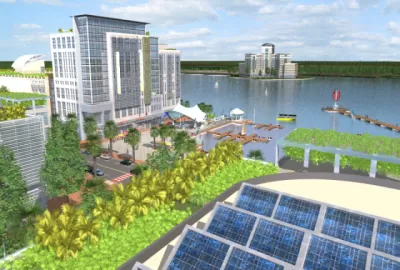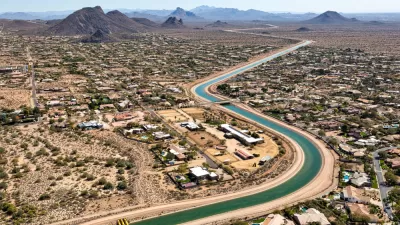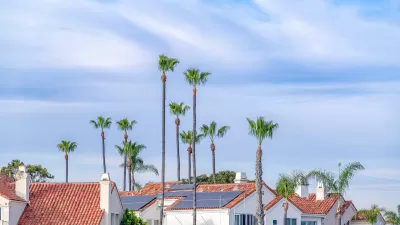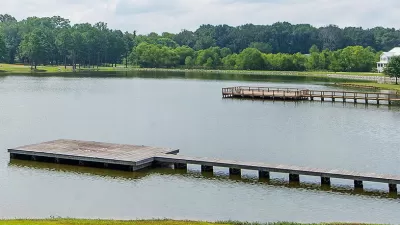Residents will live in solar powered homes and ride around the community in self-driving, solar-powered shuttles. Babcock Ranch outside of Fort Myers, Florida, has been in the making since 2005. A city of 50,000 is forecasted.

"Families are starting to move into what is being called America's first solar-powered town," announces John Dickerson for CBS This Morning on Jan. 16. "Babcock Ranch, about half an hour northeast of Fort Myers, Florida, is supposed to produce more energy than it consumes once it's finished."
Developer Syd Kitson is building 20,000 homes for a projected 50,000 people, states Dickerson in the newscast video accompanying the article.
There are more than 300,000 solar panels spread across 440 acres there, producing enough electricity not only for the town, but also the surrounding areas, reports CBS News' Manuel Bojorquez.
One critical energy element lacking in the solar-powered community will be adequate energy storage to allow the city to be truly self-powered:
The town doesn't run on solar power all the time. At night, when the sun is down, it has to draw from the traditional electrical grid. Kitson says the technology for storing all that surplus energy the solar cells generate during the day is still too costly.
The video starts with a tour of the site in a solar-powered, autonomous shuttle, hailed with an app, which will serve future residents, as well as Richard and Robin Kinley, the town's first residents. The lake was even named after them.
"I felt very much like when I bought a Tesla back in 2013 and I said, this is definitely is going to make it," Richard said. "I felt the same way about Babcock Ranch."
Like the Kinleys, Kitson, who has been working on the development since 2005, is keen on sustainability.
We want to be the most sustainable new town in the United States," Kitson said. "We had the advantage of a green field, a blank sheet of paper. When you have a blank sheet of paper like this, you really can do it right from the beginning."
Planetizen has followed the development since 2009. "More than half of the city's 17,000 acres will be permanently protected as greenways and open space, the developer said, and will adjoin the 73,000-acre Babcock Ranch Preserve that has been purchased by the state," notes the first post by Nate Berg.
The greenfield site that Kitson touts is the subject of the second post in 2011 by Shay Kahen that suggests that "when all construction CO2 emissions are factored in on these greenfield sites," a better model of sustainability is to make existing green cities, like New York, more sustainable through plans included in then Mayor Michael Bloomberg administration's PlaNYC, or today's OneNYC.
The third and final Planetizen post last year identifies significant sustainable attributes in addition to renewable energy.
The town will be walkable and bikeable, with 50 miles of nature trails. Residents will be able to plant crops in community gardens. Houses will be set near sidewalks so neighbors can more easily interact with one another. To encourage homeowners to drive electric vehicles, the town will install numerous charging stations. Its public vehicle fleet will be electric and driverless.
FULL STORY: Babcock Ranch: Inside America's first solar-powered town

Maui's Vacation Rental Debate Turns Ugly
Verbal attacks, misinformation campaigns and fistfights plague a high-stakes debate to convert thousands of vacation rentals into long-term housing.

Planetizen Federal Action Tracker
A weekly monitor of how Trump’s orders and actions are impacting planners and planning in America.

In Urban Planning, AI Prompting Could be the New Design Thinking
Creativity has long been key to great urban design. What if we see AI as our new creative partner?

King County Supportive Housing Program Offers Hope for Unhoused Residents
The county is taking a ‘Housing First’ approach that prioritizes getting people into housing, then offering wraparound supportive services.

Researchers Use AI to Get Clearer Picture of US Housing
Analysts are using artificial intelligence to supercharge their research by allowing them to comb through data faster. Though these AI tools can be error prone, they save time and housing researchers are optimistic about the future.

Making Shared Micromobility More Inclusive
Cities and shared mobility system operators can do more to include people with disabilities in planning and operations, per a new report.
Urban Design for Planners 1: Software Tools
This six-course series explores essential urban design concepts using open source software and equips planners with the tools they need to participate fully in the urban design process.
Planning for Universal Design
Learn the tools for implementing Universal Design in planning regulations.
planning NEXT
Appalachian Highlands Housing Partners
Gallatin County Department of Planning & Community Development
Mpact (founded as Rail~Volution)
City of Camden Redevelopment Agency
City of Astoria
City of Portland
City of Laramie





























